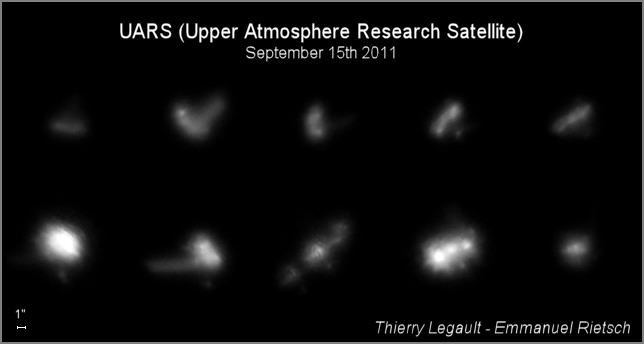The huge Upper Atmosphere Research Satellite (UARS) will be plummeting to Earth in an uncontrolled re-entry this week, but here's an incredible video from astrophotographer extraordinaire
Thierry Legault
who shot footage of UARS with his 14-inch telescope. Legault was in Northern France (Dunkerque) last week to attempt to capture views of the satellite, and had success on September 15, 2011 between 04:42:14 and 04:44:02 UTC, just 8-9 days before its atmospheric reentry, when it was at an altitude of only 250 km. The tumbling, uncontrolled nature of the satellite is obvious in this video, and various components are visible, such as the body itself and the solar arrays.
NASA has now refined its prediction for when this bus-sized satellite will fall to Earth. The 20-year-old defunct satellite now has a predicted re-entry Time of about 20:36 UTC on September 23, 2011, plus or minus 20 hours, according the the
UARS Reentry Twitter feed.
So, heads up!
[/caption]
This is a day earlier than previously anticipated. Pieces of the 6.5-ton satellite are expected to survive the fiery plunge and hit our planet, but NASA does not know exactly where. There was word today that increased activity from the Sun has hastened the decay of the satellite's orbit.
Legault said his images show the satellite at a 316 km distance to the observer. The angular speed at culmination: 1.36°/s. The speed of the sequence is accelerated two times with regard to real time (20 fps vs 10 fps). The satellite is tumbling, perhaps because of a collision with satellite debris a few years ago.
Here is the equipment Legault used: Celestron EdgeHD 14" Schmidt-Cassegrain telescope (at a focal length of 8500mm) on automatic tracking system, as described on this page. Camera: Lumenera Skynyx L2-2.
Thanks to Legault for sharing his video and images with Universe Today! See more info at
Legault's website.
[caption id="attachment_89065" align="aligncenter" width="580" caption="Map of the UARS orbital path. Credit: @UARS_Reentry Twitter feed. "]
[/caption]
NASA says there are about 26 components that are big enough to survive and make it down to Earth, the largest weighing more than 150 kg (330 pounds.)
What are you chances of getting hit by debris? Nick Johnson, chief scientist with NASA's Orbital Debris Program, said that numerically, it comes out to a chance of 1 in 3,200 that any one person anywhere in the world might be struck by a piece of debris. That might sound high, but if you factor in that there are 7 billion people on Earth and that a large part of Earth is covered by water, the liklihood is actually very small. The chance that any
one
person on Earth getting hit by debris has been estimated at about 1 in 21 trillion.
We'll provide more updates on the UARS story. For those who would like to catch a last glimpse of UARS streaking across the night sky for yourself should check
Heaven's Above
or
SpaceWeather's Satellite Tracker
for flyby times in your area.
For more information about this satellite's uncontrolled re-entry,
see our earlier article detailing UARS
.
 Universe Today
Universe Today
